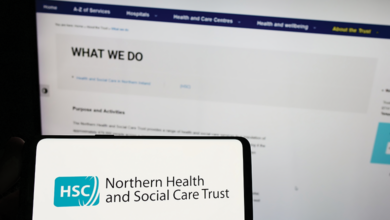Covid Co-operation

At the outbreak of the pandemic both health departments in Ireland agreed a Memorandum of Understanding (MoU) to underpin co-operation on the public health response to the virus, however, little cohesion has been evident in efforts to emerge from lockdown.
The MoU was seen as a significant step in efforts to tackle the Covid-19 pandemic on the island of Ireland for a number of reasons. The first was that in the early days of the virus being present on the island, it appeared that Northern Ireland would align its lockdown measures with decisions being taken in Westminster. Such a move would have led to vastly different approaches on either side of the border, such as the closing and opening of schools, and been ignorant of the levels of cross-border activity that exist.
The second significance was that the MoU was facilitated by Northern Ireland’s new Health Minister in the reformed Executive, Robin Swann. Cross-border initiatives between north and south have been fragmented over the past two decades due to the obvious political differences at Stormont. While health has been one of the areas whereby progress has been made on collaboration in specific areas, such as that of cancer, ambulance and congenital heart services, there remains a political tension around all-island approaches.
For these reasons, a unified response to tackling the virus was welcomed. The MoU, signed by both health ministers and by the Chief Medical Officers north and south, appeared to signal a common approach to both lockdown restrictions and also plans to ease these restrictions.
In reality, however, there has appeared to be little cohesion between the Executive and the Irish Government as they continue to roll out the easing of restrictions and roadmaps towards recovery.
The MoU set out clearly that its aspirations were a common understanding rather than the creation of legally binding rights or obligations for either side and the document does not constitute an international agreement.
“The Covid-19 pandemic does not respect borders, therefore there is a compelling case for strong cooperation including information-sharing and, where appropriate, a common approach to action in both jurisdictions,” the document states.
The MoW outlines a number of key areas where collaboration should exist. The first of which is modelling. “Participants are committed to working in partnership to predict the likely impact of COVID-19 and to enable evidence-based decisions on how best to respond across the island of Ireland.” Also included was a common public health response, stating that the governments would work to develop evidence based public health measures in both jurisdictions, “including measures such as, but not limited to case detection, testing regimens and contact tracing”.
To date, little of the actions taken by either government have reflected a unified approach to tackling the pandemic that the MoU demonstrated might be the case.
In reality, there has been little cohesion on these approaches. Difficulty in comparing the approaches of the two regimes stems from the earliest stages of the pandemic’s arrival on the island. In the earliest weeks of March, the governments took different approaches to the likes of cancellations of mass gatherings, school closures and other lockdown measures, such as the introduction of a travel limit in the Republic of Ireland, which did not exist in Northern Ireland.
Similarly, Northern Ireland chose to initially follow the British Government’s lead on moving out of a “contain phase” and largely limiting testing to hospital admissions, all but ending contact tracing. In contrast, Ireland expanded testing and contact tracing through community facilities.
While it has been recognised that government approaches may have diverged as a result of varying transmission rates, comparisons are made difficult by the differing methods of case and death reporting. In Northern Ireland alone, the death rate differs between the Department of Health’s figures, which are mostly comprised of hospital deaths, and NISRA statistics, which record all fatalities where
Covid-19 is mentioned on a death certificate. Ireland counts all deaths from the disease on a daily basis, with a recognition that additional deaths will be registered on top of the total at later dates.
A further element of the MoU is for common public messages, whereby governments should “build and reinforce core communications around handwashing, respiratory hygiene, no handshaking and other social distancing measures”. Again, some major discrepancies exist in this area. The Irish Government moved quicker than the Northern Ireland Executive to allow larger gatherings of people both outdoors and indoors. Similarly, messaging around advice for older and vulnerable people differed and most notably, both governments opted to change their “stay home” message at different times. The Northern Ireland Executive changed its branded message to “stay safe; save lives”, while Ireland promoted a “Be responsible. Be safe” message.
Research and engagement work are thought to be progressing. As expected, the MoU set out that government agencies would explore cooperation and collaboration in identified priority research areas, clinical trials and the sharing of data samples.
However, plans to “work together in appropriate areas that may arise, such as procurement, to support the response to Covid-19, where it is of mutual benefit to do so,” appear to have been undermined early on in relation to an order for PPE.
In April, Finance Minister Conor Murphy admitted that a cross-border initiative to order PPE from China, he’d originally announced, was “not fulfilled”. It’s believed that the Irish Government opted to move alone in the order because the joint order had not yet been agreed when competition from the likes of the USA and India increased. However, Ireland’s Health Minister Simon Harris has denied any knowledge of a joint order with Stormont being placed.
In the wake, the Department of Health in Northern Ireland said that discussions between procurement teams are “ongoing and active” and stated an intention for continued co-operation.
The MoU states that it seeks to ensure consistency where possible, highlighting that “for justifiable reasons the public health approach and measures adopted in the respective jurisdictions may not always mirror each other in identical fashion”. In truth, little in the two approaches to lockdown or in the subsequent recovery plans have aligned.
In March, First Minister Arlene Foster complained publicly that the Executive had not been informed of the lockdown measures being implemented in Ireland, announced by then Taoiseach Leo Varadkar. However, Varadkar made clear in announcing the lifting of some restrictions in June that he had spoken to the Executive.
To date, little of the actions taken by either government have reflected a unified approach to tackling the pandemic that the MoU demonstrated might be the case. The strength of the relationship will undoubtedly be tested further as restrictions continue to be lifted, especially in relation to travel. Currently, the governments have yet to announce a single digital system in relation to contact tracing. Ireland looks set to launch its app in late July, whereas the Northern Ireland Executive has yet to announce any formal plans away from its current manual model of contact tracing.
As both internal and external travel increases, it could be expected that the governments will need to increase levels of co-operation in order to accurately record and control the spread of the virus. However, to what extent this will happen remains to be seen.





